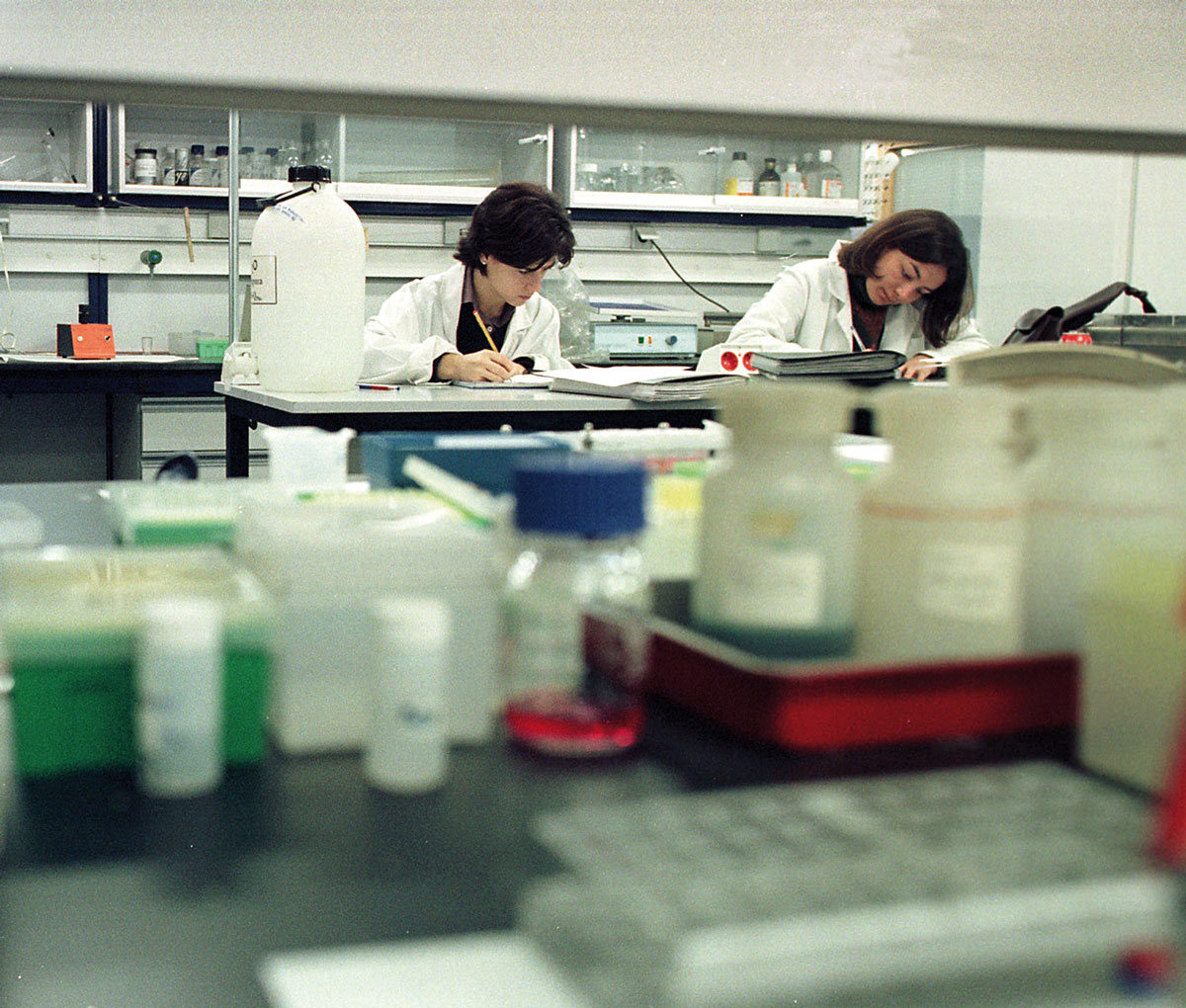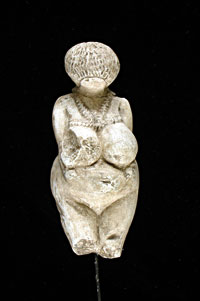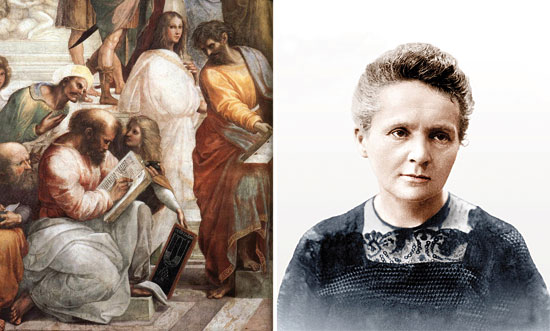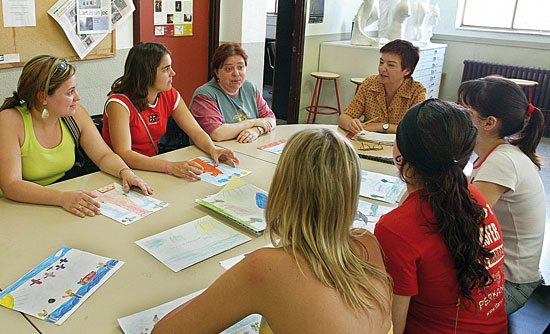
ABSTRACT
This article sets out to contribute a personal reflection, from the viewpoint of cultural history, on the contexts and conditions that led to the exclusion of women from fi elds of science. In recent decades, international feminist literature and gender studies have produced a wide historiography, providing public opinion with the bases and evidence of the social, cultural and ideological reasons that helped build gender models of a particular archetype of women and of feminine nature in Western tradition. Patriarchal, monotheistic religion, the birth of science within the context of a patriarchal order and the challenge of doing science in a democratic society constitute the main thread explored herein.
Keywords: science, patriarchal society, women, religion, exclusion.

Women were thought of as symbols of sensitivity and maternity, the Palaeolithic Venuses refl ect –as the Kostienki Venus in the picture– the physical traits linked to reproduction –belly and breasts– which are very large.
The roots of patriarchal society
Without ignoring the possibility that matriarchal societies existed around the Mediterranean prior to the invasions of warlike Indo-Aryans, who migrated from Central Asia to climatically milder regions, the fact is that Mediterranean societies in Antiquity had patriarchal organisation and culture. This was so everywhere, from the Hittites and Persians to the Egyptians, Iberians, Phoenicians, Sumerians, Babylonians and many others giving rise to the fi rst empires, emerging from the Neolithic Revolution. We have a great deal of material evidence of cults worshipping nature and fertility, and the worship of female divinities and certain women of importance, but what epitomises patriarchal society since Antiquity is the male-dominated power structure, both in social and individual relationships. Power belonged to and was transmitted through men, who were head of the family as well as the political and religious leaders. In short, in this social system, authority and power are transmitted through the male lineage and patrilineal descent, while women, children, goods and properties are subordinates.
In our tradition, the counterpoint to this singling out of man, with his leading role in public life, society, politics, art, war, science and culture, is the exclusion of woman; in other words, her «domestication», domestic reclusion, responsibility for the household economy (oikos), taking care of children, animals and domestic orderliness. The legitimisation of social order has deep ideological roots, such as the defi nition of nature as a construct of reality in terms of polarity: male/female; day/night; good/ evil; virtue/sin; light/dark… or Antiquity’s «natural philosophies», which created archetypes of masculinity and femininity, in harmony with the patriarchal social order. Meanwhile, in Hellenic tradition, the most infl uential thinkers like Aristotle, Plato or Galen constructed biological arguments based on the physiological inferiority of females: mas occasionatus, in other words, the female is an unfi nished male according to Aristotle, and woman’s psychological and moral virtues made her inferior, doomed to home, motherhood and male domination. Indeed, social order was required to be consistent with natural order, and was further legitimised by sacred or religious order. Galen’s humoralism, steeped in Aristotelianism, spread a doctrine of temperaments according to which masculine humour was characterised by strength, intelligence, action, and a constructive spirit, while the female humour was identified with sensitivity, affection, materiality, passivity; namely qualities, moods and temperaments that relegated females to the domestic role of motherhood.

When females sought an existence outside the purely domestic ambit, then they became a destabilising and subversive factor. This was Hypatia’s case (on the left), mathematician and astronomer from the 4th century considered the first woman scientist, or Marie Curie’s (on the right), chemist and physicist, who was awarded two Nobel prizes for her pioneer work on radioactivity.
Monotheism and misogyny
Biological and social inferiority of women was defi nitively reinforced in our cultural tradition by spiritual inferiority. The transition from polytheism, which was more or less compatible with natural philosophy, to «patriarchal monotheism» supported women’s subordination to men even more than before. Christianity, Judaism and Islam share deeply misogynist religious roots, an essential part of their dogma. Christian anthropology claimed by some as the true hallmark of Western Europe, established in the early councils that illuminated Patristics, along with the ideas of Paul of Tarsus and Augustine of Hippo, not only the spiritual inferiority of women, but they also deprived her of a soul, an essential element of the human condition, calling into question women’s spiritual identity and right to salvation. Modernity was to witness many theological debates before women –always considered humanly and spiritually inferior– were to receive some recognition of human spirituality owing to Mary, the mother of Christ. It is no coincidence that all patriarchal mythologies portray women –be they called Eve or Pandora– in disgrace, as the source of evil, sickness, pain and death. Women were depicted as curious and fi ckle, sensitive, and of limited intelligence. Women were guilty of breaking the sacred order established by God the Father; they were sinful, seductive, evil incarnate. Patriarchal power in classical societies was based on a solid understanding of the human condition, legitimised by religious, philosophical and biological elements that contributed certain coherence to the physiological, social and spiritual inferiority of women compared to men.
«What epitomises patriarchal society since antiquity is the male-dominated power structure,both in social and individual relationships»
Demoted to a condition of inferiority, contact with a female would always diminish and endanger male perfection, be it in the spiritual or physical dimension. So it was some doctors saw women as bearers of disease (venereal), a risk, while priests saw them as a threat to spiritual perfection, a reason for celibacy. Patriarchal monotheistic religions have viewed women from the perspective of fear and danger.
A woman’s status as an individual, social, intellectual and spiritual entity has traditionally been hidden behind subordination to male dominance and sacred patriarchal order. When females sought an existence outside the purely domestic ambit, then they became a destabilising and subversive factor. Some examples are Hypatia during Antiquity, Oliva Sabuco during the Renaissance; or Marie Curie in contemporary society, to which we must also add the numerous witches, healers, midwives and abortionists who fell victim of judges, physicians or inquisitors –all instruments of patriarchal power–, and prey to the taste of torture and bonfi re fl ames from the anonymity of history.

Photo: Miguel Lorenzo
Science under the patriarchal order
Dating from the natural philosophies wrought during Antiquity, Science –in other words, knowledge of nature and its laws built up from secular rationality– belonged solely to masculine and aristocratic elites, that is, linked to the nobility and religious hierarchy. Knowledge, be it theological, philosophical or scientific, was the heritage of powerful groups. Moreover, knowledge has historically been an instrument of domination and perpetuation, as well as a source of conflict between dominant social groups at times. The knowledge regime corresponding to each society in each epoch reflects the intellectual and social order, the players, dynamics and scientific practices can only be understood within the historical context, bearing in mind the inseparable universe comprising the knowledge regime and social dynamics. Historically, at this intersection of knowledge and power, women were not to be found; indeed, they were most conspicuously absent.
«Antiquity’s “Natural Philosophies” created archetypes of masculinity and femininity, in harmony with the patriarchal social order»
If the Neolithic Revolution and the patriarchal feudal regime marked the genesis, representing the deepest roots of exclusion, so the Enlightenment broke with the power dynamics of the manorial society of the Ancien Régime. United power was androcentric and patriarchal, but the new political philosophy of Montesquieu and Jefferson –personalising the political ideology of the French Revolution and the American Revolution, the result of complex, contradictory and conflicting processes– was to instate a new system of values that would lead to the construction of a new social reality with the slow transformation of the liberal society and the workers’ struggles of the nineteenth and twentieth centuries. Civil rights, the essential and universal dignity of the human condition, formed the nucleus crystallising a new social model of intersex relationships. Political realisation of the universality of human rights was the starting point of women’s emergence in the public sphere and also, gradually, in the world of education, culture and science; a terrain conquered only at the expense of deconstructing the old patriarchal universe monopolised by men. A conquest frequently threatened by the weight of tradition, always at the risk of a setback due to the surviving patriarchal structures: institutionalised religious hierarchies, the perpetuation of role models, as well as family and cultural traditions … In today’s world, the achievement of legal and social equality between the sexes is highly inconsistent, and parity can only be consolidated by the inclusion of women in the fi eld of science and in social and political powerhouses.

Beyond the woman’s conception as a mother, science and medicine have also portrayed women in a negative way, a vision linked to a negative conception of sexuality. In the picture, a poster from the Spanish Civil War warning soldiers about the dangers of venereal diseases. / University of Valencia
Women and science in a democratic society
The situation changed noticeably in the second half of the twentieth century. The main driver of this transformation took the form of feminist movements and tireless activism led by women’s groups and associations. In 1984, the United Nations Advisory Committee on Science and Technology for Development was to inaugurate the Programme for Science and Technology, and Women, thereby introducing the gender perspective to scientifi c professions. In 1995, the Working Group responsible for designing the programme presented a Declaration of Intent to the Economic and Social Council of the United Nations, outlining an agenda of transformdriving actions to be undertaken in terms of gender, science and technology, adopted by the Fourth World Conference on Women and Development held in Beijing in 1995. The 1990s marked a turning point in the marginalisation of women in science.
The UNESCO World Science Report (1996) incorporated a chapter on «The gender dimensions in Science and Technology». Coordinated by S. Harding and E. McGregor. It established a conceptual framework for refl ection and statistical data concerning formal and informal education, access to higher education, employment and participation in professional life. Sociological studies looking at the presence of women in different areas of the labour market have been highly enlightening and, at the same time, a fundamental basis for social and political action.
The 12th Directorate General for the European Communities Commission organised an international meeting in Brussels in February 1993, which gave rise to the Women in Science. report edited by H.A. Logue and L.M. Talapessy, with the participation of people from Member States, the Commission and the European Parliament. In 1998 the European Union Directorate General for Research created a task force to analyse the situation of women in the scientifi c world. This group produced a report on Science Policy in the European Union, subtitled Promoting Excellence through Mainstreaming Gender Equality known as the ETAN Report (2000). After studying the participation of women in science and technology in European countries, the report concluded that «under-representation of women threatens the goals of achieving scientifi c excellence, as well as being a waste of resources and an injustice». This was obviously a major factor in achieving change: to sway public opinion and convince leaders of the unjust female marginalisation within the fi eld of science, a morally unjustifiable situation.
The report was the follow-up of the Woman and Science conference held in April 1998 at the European Parliament and the Commission stressed «the need to intensify efforts to increase the presence of women in research in Europe». The objective was set out clearly. Subsequent resolutions passed by the European Parliament and approval of a Plan of Action by the European Commission (February 1999) provided a roadmap for women and science within the Fifth Framework Programme for Scientific and Technological Development (1999 -2002).

Photo: Miguel Lorenzo
Regarding the participation of women in research underway in the industrial and the private sectors, there is little solid or verifi able data. Public information within this area is more diffi cult to obtain, and the European Union once again promoted a study on this topic entitled: Women in Industrial Research: A Wake up Call for European Industry (2003). The European Union also published the report Women in Science and Technology. The Business Perspective (2003), resulting from the Wake up Call for European Industry programme. International mobilisation has had repercussions in Spain, including the creation of AMIT (Association for Women in Science and Technology) in 2001. During the last decade a number of legislative developments have tried to eradicate inequality and ensure greater female presence in managerial boards related to planning, organisation, recruitment, leadership and scientifi c guidance. Then in 2002, the Spanish Parliament passed a motion for a law related to «improving the situation of woman in science and technology», which was to give rise to AMIT’s «Declaration and Strategies 2003». On March 8, 2005 the socialist government was to publish an Act in the offi cial state bulletin (BOE) by which «the government will take measures to favour equality between women and men in our country». Article 1.3 established that gender parity should exist in the recruitment boards of Central Government as well as of State agencies and government-dependent companies. In addition, Article 4.1 created the UMYC (Women and Science Unit) to analyse and improve the situation of women in scientifi c institutions. In 2007, research projects incorporated a positive-discrimination measure to promote women’s participation. Furthermore, the Ley de Igualdad, Spanish Equality Act (2007), aimed to eliminate the hurdles that prevented women from reaching the governing bodies of institutions by creating specific gender-equality programmes. Several reports by the FECYT (Spanish Foundation for Science and Technology, 2007) have also analysed the situation and proposed strategic action plans.
«Even today men’s trackrecords reflect more prestigious and better paid careers»
At the start of the new millennium, women’s access to university education was a reality. According to the Vice-Chancellor’s Conference (CRUE), 54.2% of Spanish university students were women in 2002. However, this proportion began to drop at postdoctoral level, which marks the start of the scientifi c and research career. However, in 2005, 60.6% of graduates and 51.5% of doctorate students were women. Moreover, scientifi c productivity studies among research groups would indicate that there are signifi cant differences between the performance of men and women.
«During the last decade a number of legislative developments have tried to eradicate inequality and ensure greater female presence on scientific managerial boards»
Although it may be true that women’s access to science and technology is a reality, there are substantial differences in terms of scientifi c fi eld. All in all, the data indicate that –even today– men’s track-records refl ect more prestigious and better paid careers. In 2005, female researchers at the CSIC (Spanish Scientifi c Research Council) accounted for 31.4% while 34.9% of university professors were women: however, the numbers were quite different when considering university chairs (13.7%) and the highest research level, CSIC research professors (15%). The number of vicechancellors (4 out of 72) was purely symbolic. In 2007, there were only three women among the 36 members of the Spanish Royal Academy of History (Real Academia de la Historia), while in the Academy of exact, physical, chemical and natural sciences (Academia de Ciencias exactas, físicas, químicas y naturales), there were only two women out of 55 members, similar to the minority representation within the Spanish Royal National Academy of Medicine (Real Academia Nacional de Medicina) with just two women out of a total of 46 members. Indeed, if we look at the ten royal academies in Spain, women represent only 5.53%. These fi gures clearly show how slowly women are gaining access to positions of leadership, responsibility and prestige.
The serious crisis in recent years, representing a grave threat to Spanish society, should not stop this feminisation process of techno-science; a process that must be protected with special care so as not to undermine the endeavours of so many people, over such a very long time.
References
Committee on Women, Science, Engineering and Technology, 1994. Rising Tide: A Report on Women in Science, Engineering and Technology. HMSO. London.
FECYT, 2007. Mujer y Ciencia. La situación de las mujeres en el sistema español de ciencia y tecnología. (2a ed.). Fundación Española para la Ciencia y la Tecnología. Madrid.
Foucault, M., 1969. L'Archéologie du Savoir. Gallimard. Paris.
Keller, E. F. i H. E. Longino, (eds.), 1996. Feminism and Science. Oxford University Press. Oxford.
Lacqueur, Th. 1992. Making Sex: Body and Gender from the Greeks to Freud. Harvard University Press. Boston.
Latour, B. 2004. Politics of Nature: How to Bring the Sciences into Democracy. Harvard University Press. Boston.
Logue, H. A. i L. M. Talapessy, 1993. Women in Science – International Workshop 15th and 16th Feb. 1993, Brussels – Proceedings. Office for Official Publications of the European Communities. Luxemburg.
Miqueo, C. et al., 2011. Ellas también cuentan: Científicas en los comités de revistas biomédicas. Universidad de Zaragoza. Zaragoza.
Ortiz Gómez, T. i G. Becerra Conde ( eds.), 1996. Mujeres de ciencias. Universidad de Granada. Granada.
Schiebinger, L. 1989. The Mind Has No Sex? Women in the Origins of Modern Science. Harvard University Press. Cambridge.





